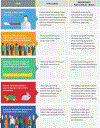Moving geroscience from the bench to clinical care and health policy
- PMID: 34145908
- PMCID: PMC10202082
- DOI: 10.1111/jgs.17301
Moving geroscience from the bench to clinical care and health policy
Abstract
Geriatricians and others must embrace the emerging field of geroscience. Until recently geroscience research was pursued in laboratory animals, but now this field requires specialized expertise in the care of vulnerable older patients with multiple chronic diseases and geriatric syndromes, the population likely to benefit the most from emerging therapies. While chronological aging measures the inevitable passage of clock time that occurs equally for everyone, biological aging varies among individuals, and importantly, it is modifiable. Advances in our understanding of biological aging, the discovery of strategies for modifying its rate, and an appreciation of aging as a shared risk factor for chronic diseases have jointly led to the Geroscience Hypothesis. This hypothesis states that interventions modifying aging biology can slow its progression-resulting in the delay or prevention of the onset of multiple diseases and disorders. Here we wish to report on the Third Geroscience Summit held at National Institutes of Health on November 4-5, 2019, which highlighted the importance of engaging other disciplines including clinicians. Involvement by scientists with expertise in clinical trials, health outcomes research, behavioral and social sciences, health policy, and economics is urgently needed to translate geroscience discoveries from the bench to clinical care and health policy. Adding to the urgency of broadening this geroscience coalition is the emergence of biological aging as one the most important modifiable factors of COVID-19, combined with the inability of our society to once again recognize and confront aging as a priority and opportunity when facing these types of public health emergencies.
Keywords: aging; economy; geriatricians; geroscience; social.
© 2021 The American Geriatrics Society.
Conflict of interest statement
CONFLICT OF INTEREST
Gordon J. Lithgow is a scientific founder of Gerostate Alpha. Eric Verdin is a scientific founder of Napa Therapeutics. Laura Haynes and George A. Kuchel are consultants for Spring Discovery.
Figures


References
-
- Neugarten BL, Havighurst RJ. Extending the Human Life Span: Social Policy and Social Ethics. NSF/RA 770123. Chicago: National Science Foundation, University of Chicago Press; 1977.
-
- Olshansky SJ, Hayflick L. Public policies intended to influence adult mortality. In: Rogers RG, Crimmins EM, eds. International Handbook of Adult Mortality. Vol 2. Springer, Heidelberg: IHOP; 2011:571–581.
-
- Hayflick L. The cell biology of aging. Clin Geriatr Med. 1985;1:15–27. - PubMed
-
- Cristofalo VJ, Pignolo RJ. Replicative senescence of human fibroblast-like in culture. Physiol Rev. 1995;72:617–638. - PubMed
MeSH terms
Grants and funding
LinkOut - more resources
Full Text Sources
Medical

